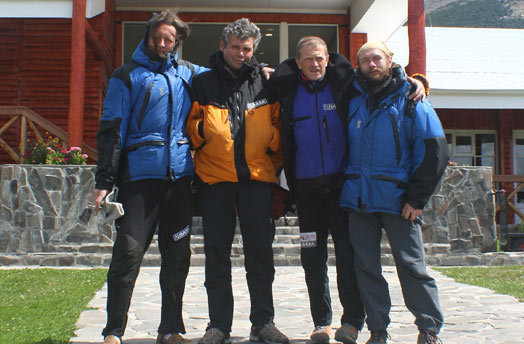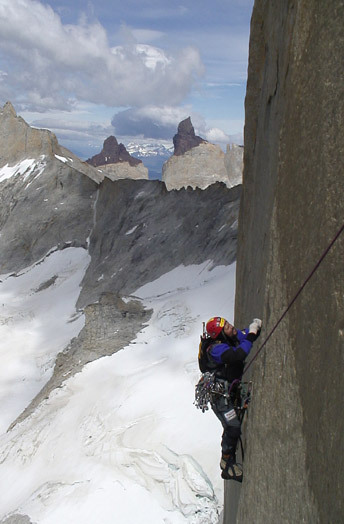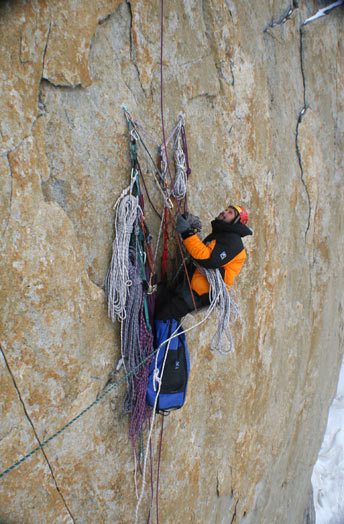
The Russian-Ukrainian team that made the second ascent of Golazo (VI 5.10 A4+, 1200m, Schneider, 1999) on the Central Tower of Paine, Patagonia, Chile. From left to right: Tim Akhmedkhanov, Sergiy Kovalov, Arkadiy Seregin and Igor Pekhterev. [Photo] Arkadiy Seregin
In the March 28 NewsWire there was a brief report on the second ascent of Golazo, Steve Schneider’s hard solo effort on the East Face of Central Tower of Paine, Patagonia, Chile. We can now provide more details. The Russian-Ukrainian team, comprising Tim Akhmedkhanov, Igor Pekhterev and leader Arkadiy Seregin (all from Russia), with Sergiy Kovalov from the Ukraine, arrived in Puerto Natales on January 9 and started fixing rope on the initial pitches of the route five days later. On January 20 they reached the big ledge atop Pitch 9 and established two portaledges. After fixing Pitch 10 (A3+) the following day, they were forced down by a storm. Fortunately, this wasn’t for long, and by January 24 they were back on the wall with 150 liters of water they had to carry from the lower section of the glacier. They also took twelve ropes and decided to fix them all.

Sergiy Kovalov getting a bit of respite on Pitch 14, which follows Golazo’s three crux pitches. Pitches 11-13 were very difficult and took huge quantities of copperheads, beaks and RURPs. [Photo] Arkadiy Seregin
It took six days to climb the next three pitches: Pitch 11, A5; Pitch 12, A4/A4+; Pitch 13 A3+ (Schneider graded the crux pitch A4+). These were very hard and required huge quantities of copperheads, beaks and RURPs. It was so cold on the belays that they had to sit inside the haul bags to maintain even a remote sense of warmth. In addition, it was also windy more or less every day–one of their main base camp tents was broken on the very first night.
Pitches 14-21 were A2 or A2+ and were climbed somewhat faster. While the first fifteen pitches had two bolts at each belay, above there was only one, so the team added a second bolt to all higher stances. On February 2 Akhedkahnov and Pekhterev were given the task of finishing Pitches 20 and 21, and then the next day all four climbers would try for the summit. They thought this very practical as they knew Schneider had worked from a portaledge camp at the top of Pitch 14, fixed to the top of 18 and then from there gone for the summit.
February 2 was a rest day for Kovalov and Seregin. It was sunny with valley clouds below and streaks of high-altitude cover above. Seregin decided to check the food situation. It looked very promising: there were 300 grams of whiskey and enough food to make one more meal. Because of this, at midday he suggested to Kovalov that they go for the summit immediately and not wait for the following day. Kovalov demurred. It was cold and he didn’t want to leave his sleeping bag. Seregin promised him bad weather on the following day; Kovalov didn’t believe him. Seregin pointed out the valley mist and streaky high clouds. Kovalov said it would be fine the next day. Seregin eventually had to forcibly evict him from the portaledge and the pair started jumaring at 1:30 p.m.
It took them four hours to reach the other two at the top of pitch 20, then after Akhedkahnov had finished leading pitch 21, they removed three ropes from the pitches below and went for the summit. Seregin was overjoyed to find that by 8 p.m. it was snowing, just as he had predicted. Fortunately, the climbing was relatively straightforward, though the rock was quite icy. The leader wore crampons and carried two axes, while the rest followed as best they could. At 11:20 p.m. all four were standing triumphantly on the summit of the Central Tower.

Sergiy Kovalov belaying at the top of Pitch 14 on Golazo. He has his legs inside the haul bag in order to keep warm. [Photo] Arkadiy Seregin
The descent was uneventful, the four helped enormously by calm conditions. By 6 a.m. on February 3 they had regained the portaledges. A big Patagonian storm began two hours later as they were descending the lower part of the wall, but by 4 p.m. all were safely on the glacier.
In February 1999 Christian Santelices and Steve Schneider started up the East Face of the Central Tower to the right of the British line, El Regalo de Mwoma (VI 5.10 A4, 1200m, Craine-Prichard- Smith-Yates, 1992). After seven days on the wall and twelve pitches up, Santelices decided it wasn’t for him. Schneider continued solo, climbing alone for eleven days to complete the most difficult aid route to date on the Towers. He named it after the locally bought chocolate bars eaten on the climb: Golazo (VI 5.10 A4+, 1200m, Schneider, 1999). Seregin feels that this route is definitely harder than Reticent Wall on El Capitan and that Schneider is a real hero. “He did a hard job: I’m going to send him a bottle of our good Russian vodka”.